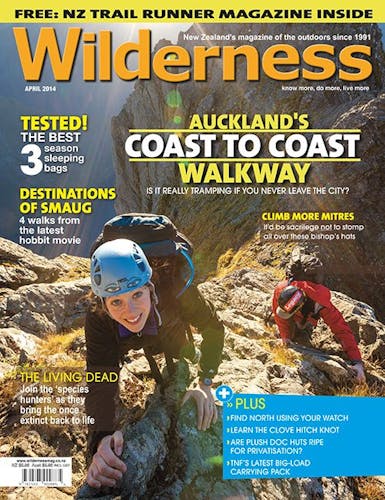The outdoor world is obsessed with action right now. It’s all about climbing up things and jumping off them, paddling around things and running across them – and trying to do it all faster than the last person. But in a quiet corner of Central Otago there’s at least one guy taking a very different approach. Mark Banham reports
“We probably should talk a bit about why I’m out here, eh.” Toby Eglesfield says, not even looking up from his paper as his pencil steadily works across his sketch pad, gradually replacing white space with a stylised forest scene.
The quirky Englishman is half-way through an epic 32-part montage of bush drawings set near the Mt Chrichton Track, west of Queenstown. It’s a project that’s made him somewhat of a strange fish in both the art world and the outdoor community.
The usual modus operandi for this sort of art project would be simple: you’d just snap some promising looking photos, take them back to a nice warm studio, put the kettle on and start transcribing onto canvas. But Eglesfield has gone for a different approach.
He’s doing pretty much the whole thing on site, en plein air as it’s known in the trade. It means taking the increasingly urban pursuit of art and dragging it kicking and screaming back to its Neolithic outdoor roots – these days it’s not a place where it sits comfortably.
This morning I’ve followed him about an hour into the forest off the Glenorchy-Queenstown Road, into a narrow creek bed. There’s no trail so we’ve waded up the creek to an impassable waterfall with a small beach below it: one of the thirty-two carefully selected locations.
At our feet a small stream meanders towards Lake Wakatipu, while around us fallen beech trees decay into soil and a squadron of fantails dogfight with the sandflies, the sunlight catching their tails as they manoeuvre. I don’t know much about art, but this seems like a nice enough place to hang out for a while.
That’s certainly a good thing, because over the last year or so, Eglesfield’s been spending a fair amount of time at this spot and others like it.
“You’ll have to do the math,” he says, “but it’s taking about five and a half hours per drawing in the field, then 12 hours to re-draw them onto the larger sheet, plus about an hour each way to get to each spot… and three or four days of location scouting.”
To save you getting your calculator out, that’s 656 hours – or more than sixteen forty-hour weeks of work.
Mountaineers and climbers have always struggled to explain why they do what they do, the very particular ways they do it. Questions like: ‘Why not just use a helicopter?’, ‘Why can’t you drill a bolt anchor there?’ and ‘Why don’t you just ask someone else how they got up it?’ tend to stump even the most articulate alpinists. Talking with Toby it’s hard not to see the parallels with his artistic Everest.
“People say ‘why don’t you just work from photos?’. And I guess someone could do that – I could do that – but I think you’d get a different result because you’d be referencing something static.
“The light wouldn’t be changing and you wouldn’t hear any of these sounds. Obviously the sounds don’t come out in the drawing, but it’s going to affect your mind-state.
“I think the main thing is that just being here means you’re experiencing what you’re drawing, whereas if you look at a photo, you’re not; it’s just a bunch of lines and shapes.”
It’s a warm day but in the depths of the valley the air is brisk. After an hour of chatting to Eglesfield, I can feel the cold beginning to creep under my skin and my backside is starting to go numb against the unforgiving shingle. You’ve got to suffer for your art I suppose.
“So what’s been the hardest bit?” I ask, expecting to hear horror stories about sandflies big enough to carry off small children.
“Actually, the sandflies aren’t that bad when you get used to them,” he says. “I don’t mind them on my arms and legs, but when they get in around your eyes – that’s really crossing the line.”
Although cold can be a concern and rain can of course put the kibosh on things at just about any moment, Eglesfield says the biggest challenges are to do with the work itself.
“Different locations come alive in different light. Often figuring out what works when is a matter of trial and error,” he says, “The worst one is just getting overwhelmed by how much detail there is.”
He says that’s possibly why landscapes traditionally take “commanding and expansive views”.
“A lot of people like to survey the land, look over the mountains and see it all there. I like that, don’t get me wrong, but it’s just one part of it.
“The forest isn’t like that so much, but it definitely does something for me. But it’s not so much about looking over things and feeling in charge, it’s more about being a part of something.”
Eglesfield’s project is all about embracing the scenes most outdoorspeople only witness as a fleeting glance as they pass by. But even his lingering gaze must eventually move on. He says he’s got about a year of drawing left. After that, he hopes to exhibit the finished work and then inevitably move on to the next project – based on the New Zealand bush if he has his way.







